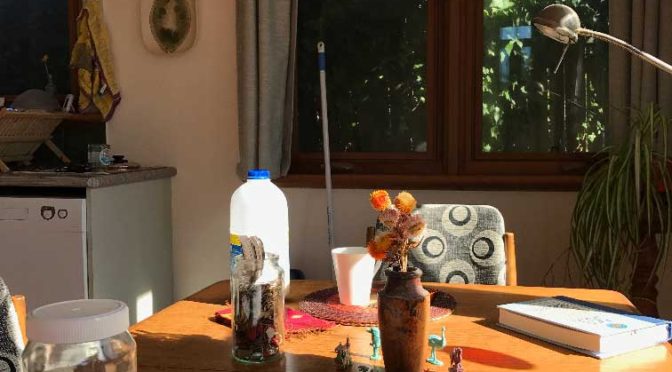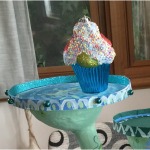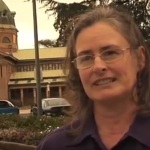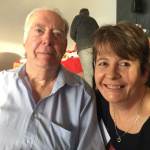Forgive me readers, but it is nearly a year since my last blog post. Quite happy to say some Hail Marys or do other forms of penance. I published a novel in February, as you’re know doubt aware (smiley face), and I’ve been trekking all over the country promoting it, so it feels like I’ve been talking non-stop even though this blog has been on radio silence.
Speaking of radio silence, let’s talk about the Dish! Readers of The Lucky Galah will know that the Dish is one of my characters. The Dish sends and receives messages from Lucky the galah, and that’s how they discover more about what’s going on in the town of Port Badminton.
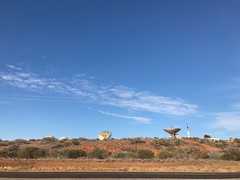 In April, I went back to the Source, which is the big satellite dish that sits on the red sand dune on the outskirts of Carnarvon. That Dish is the inspiration for my Dish, and Carnarvon is the inspiration for Port Badminton. And the whole place is infused with the culture of the Yinggarda people who have lived there on Yamaji Country from time immemorial.
In April, I went back to the Source, which is the big satellite dish that sits on the red sand dune on the outskirts of Carnarvon. That Dish is the inspiration for my Dish, and Carnarvon is the inspiration for Port Badminton. And the whole place is infused with the culture of the Yinggarda people who have lived there on Yamaji Country from time immemorial.
I flew from Perth to Carnarvon on an expensive Skippers flight (the frequency and affordability of flights in and out of Carnarvon has been a vexed issue; the service has now been taken over by Rex). I hired a silver Mitsubishi Outlander and even before checking into the caravan park, began to trawl around the sites that are now woven through my being: the One Mile Jetty, Pelican Point, Dwyers Leap, the Gascoyne River, Chinaman’s Pool, the Dish, the Fascine. Once again I was drinking the water of this place, eating its food and scuffing my feet in its pinky-yellow sand and gravel and red dirt and patchy grass.
Now, three months later, in the depths of a Bathurst winter, I’m constantly thinking my way back across the continent: back along the long roads, the hours of airtime, the view through the window of a Qantas plane into pure pink sunset, the Skippers terminal full of working men in high vis on their way to the mines up north.
Thinking my way back across the continent of Australia, the world seems big again; sitting slumped at a computer screen with Donald Trump and Vladimir Putin in my face, it feels alarmingly small. I want to get back to the uncluttered bigness of Western Australian skies, where the world returns to mystery and possibility. An adventure.
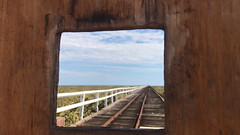 I headed for the One Mile Jetty first, as if paying respects to a venerable relative. There it was, with time collapsing in the familiar feel of the wind, the smell of seaweed. The same and yet different. The long finger out into the Indian Ocean is closed to the public now. It’s all boarded up, the hoardings covered with posters telling of the sea creatures hereabouts: parrotfish, manta ray, mulloway, crayfish, nudibranch, blue swimmer crab, bottlenose dolphin. In the middle there’s a small square window cut into the board that you can step up to and peer through. You get to see it again, stretching out into the sea just as it always did, only it’s old now, and so weak that you’re not allowed to set foot on it.
I headed for the One Mile Jetty first, as if paying respects to a venerable relative. There it was, with time collapsing in the familiar feel of the wind, the smell of seaweed. The same and yet different. The long finger out into the Indian Ocean is closed to the public now. It’s all boarded up, the hoardings covered with posters telling of the sea creatures hereabouts: parrotfish, manta ray, mulloway, crayfish, nudibranch, blue swimmer crab, bottlenose dolphin. In the middle there’s a small square window cut into the board that you can step up to and peer through. You get to see it again, stretching out into the sea just as it always did, only it’s old now, and so weak that you’re not allowed to set foot on it.
Next, I drove in to Dwyers Leap at the mouth of the Gascoyne, where decades of flood have altered the lines of land and water since we were there among the speedboats in our coloured terry-towelling hats. I watched the sunlight sparkling on water just as I did as a child. Standing on the rippled silt, I got a call from Les Bateman who’d worked at the Tracking Station in the 1970s. I’d been going to spend more time just mooching around by myself, marinated in memories and familiar sensations, but now I decided to head up to the Dish.
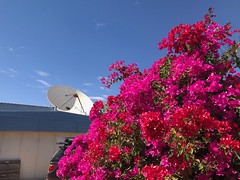 There it was, with the Space Museum at its foot, a riot of bougainvillea around the entrance. Carloads of visitors were going in and out.
There it was, with the Space Museum at its foot, a riot of bougainvillea around the entrance. Carloads of visitors were going in and out.
Les took me down to a small building below the main complex, tiny with a domed roof, a bit like a Dalek. Here, I discovered that space science on this red sand dune is still alive after all. There were two scientists crammed into the structure as big as two back yard toilets stuck together, with a ladder up to the domed area above.
Steven Hale and Eddie Ross from the University of Birmingham were in Carnarvon in April to tend equipment measuring seismic activity on the sun (the “earthquakes” of the sun, or “helioseismology”). When they’re not around, Les Bateman, who lives in Carnarvon, looks in on the equipment to make sure it’s still working.
The station is part of the Birmingham Solar-Oscillations Network, aka BiSON. Steve and Eddie had a stuffed toy bison on the desk as a mascot, which they brought outside with them when I lined them up for a photo. Steve and Eddie quietly come and go from the Carnarvon station (there are other BiSON stations dotted around the world and there’s another one in Australia at Narrabri in New South Wales) staying at what used to be called Tuckey’s Flats, now Carnarvon Central Apartments.
After that, I continued my lap around the old haunts. The old prawning jetty (let us pause to acknowledge the fictional Kevin Kelly) dissolving into the sea. Samphire flats, mangroves. A mother and small child playing on the shining wet sand in the last light at Pelican Point.
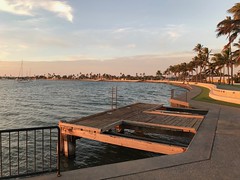 The Fascine, that sweep of sea wall at the bottom of Robinson street, has had a make-over. It has a twenty-first century look about it now, although the improvements used a type of metal that is already starting to rust. The new sea wall respectfully skirts around the old T-jetty where we used to catch puffed-up spiky blowfish and maybe – like the kids in The Lucky Galah – we threw them under the wheels of passing cars to hear them pop.
The Fascine, that sweep of sea wall at the bottom of Robinson street, has had a make-over. It has a twenty-first century look about it now, although the improvements used a type of metal that is already starting to rust. The new sea wall respectfully skirts around the old T-jetty where we used to catch puffed-up spiky blowfish and maybe – like the kids in The Lucky Galah – we threw them under the wheels of passing cars to hear them pop.
 On the Saturday, having teamed up with a couple of old school friends, Tricia (who flew up from Perth) and Ellen (who still lives in Carnarvon), I gave an author talk at the Space Museum. There was a momentary panic when I had Tricia and Ellen dashing around town looking for the morning tea. (I’d organised cakes and sandwiches over the phone from Bathurst, neglecting to pay attention to exactly which bakery I was ordering from.) They got back just in time with the foil-covered plates. The scientists from Birmingham University came along, as did school friends Noelene and Jackie and a few others. A small audience, true, but that was okay because I was hitting a Major Life Goal Bucket List Cross-Off. I was at the Dish with my own published novel in hand. Win! I’d over-catered, but as we left I noticed Museum visitors enjoying the left-over cake.
On the Saturday, having teamed up with a couple of old school friends, Tricia (who flew up from Perth) and Ellen (who still lives in Carnarvon), I gave an author talk at the Space Museum. There was a momentary panic when I had Tricia and Ellen dashing around town looking for the morning tea. (I’d organised cakes and sandwiches over the phone from Bathurst, neglecting to pay attention to exactly which bakery I was ordering from.) They got back just in time with the foil-covered plates. The scientists from Birmingham University came along, as did school friends Noelene and Jackie and a few others. A small audience, true, but that was okay because I was hitting a Major Life Goal Bucket List Cross-Off. I was at the Dish with my own published novel in hand. Win! I’d over-catered, but as we left I noticed Museum visitors enjoying the left-over cake.
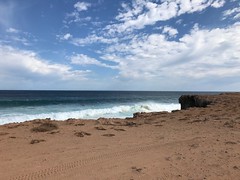 Tricia and Ellen and I headed for Quobba Station north of the Blowholes. We stayed in a chalet and communed with the crash of the ocean and giant golden-orange sunsets streaked with blotches of grey cloud. On the beach, I crouched down to admire the giant clam shells like the ones Mrs Boon used to paint scenes of the Blowholes on. We had the idea to do a day-trip to Coral Bay on the Ningaloo Reef where you can swim with whale sharks. We wouldn’t swim, though, we’d just have lunch there. The sensible thing would be to head back out to the sealed highway and head north that way, but seeing we had a four-wheel drive, why not take the dirt road that hugs the coast?
Tricia and Ellen and I headed for Quobba Station north of the Blowholes. We stayed in a chalet and communed with the crash of the ocean and giant golden-orange sunsets streaked with blotches of grey cloud. On the beach, I crouched down to admire the giant clam shells like the ones Mrs Boon used to paint scenes of the Blowholes on. We had the idea to do a day-trip to Coral Bay on the Ningaloo Reef where you can swim with whale sharks. We wouldn’t swim, though, we’d just have lunch there. The sensible thing would be to head back out to the sealed highway and head north that way, but seeing we had a four-wheel drive, why not take the dirt road that hugs the coast?
Bad. Idea.
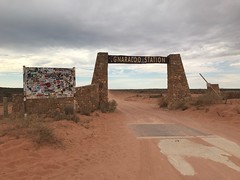 We were, of course, out of range of Google Maps. The dirt road went on and on and on, sometimes juddering over corrugations, sometimes threatening to consume the Outlander in soft drifts of sand. Western Australia is a giant and it doesn’t care about three women in a silver Outlander. What if we broke down? I started to berate myself for being just like the stupid tourists who drive into the outback in their air conditioned cars, break down and die a horrible death before anyone can find them. But then, finally, the great stone archway of Gnarloo Station hove into view. It was still a rough old ride to the homestead, but it gave us a renewed sense of destination and purpose. At the homestead, we were told that the track between Gnarloo and Coral Bay hadn’t been used for at least a decade. Oh well, forget Coral Bay. Let’s check out Gnarloo!
We were, of course, out of range of Google Maps. The dirt road went on and on and on, sometimes juddering over corrugations, sometimes threatening to consume the Outlander in soft drifts of sand. Western Australia is a giant and it doesn’t care about three women in a silver Outlander. What if we broke down? I started to berate myself for being just like the stupid tourists who drive into the outback in their air conditioned cars, break down and die a horrible death before anyone can find them. But then, finally, the great stone archway of Gnarloo Station hove into view. It was still a rough old ride to the homestead, but it gave us a renewed sense of destination and purpose. At the homestead, we were told that the track between Gnarloo and Coral Bay hadn’t been used for at least a decade. Oh well, forget Coral Bay. Let’s check out Gnarloo!
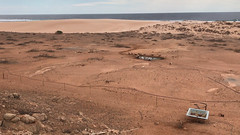 Gnarloo was strange. This was new territory, a place I’d never been before. The land rose like a great pink wave from which you looked down into a valley studded with bands of hardy goats. Beyond that rose another wave, this time of pure sand dune. It was dramatic and slightly unnerving. All around, there were stone chalets being built as the station diversified from livestock into tourism. The chalets were made out of the same pinkish rock as the surrounding landscape. It felt like a scene out of a science fiction movie.
Gnarloo was strange. This was new territory, a place I’d never been before. The land rose like a great pink wave from which you looked down into a valley studded with bands of hardy goats. Beyond that rose another wave, this time of pure sand dune. It was dramatic and slightly unnerving. All around, there were stone chalets being built as the station diversified from livestock into tourism. The chalets were made out of the same pinkish rock as the surrounding landscape. It felt like a scene out of a science fiction movie.
We made our way back to the more familiar landscape at Quobba, and another evening of sunset, crashing waves and memories. Names, families, comings and goings, hatchings and matchings, the answers to some puzzles, the deepening of certain mysteries.
Back in town, Tricia and Ellen performed a re-enactment of a photograph I took of them in Year 11, standing near the gate at the high school. We examined the plaques marking the spots where time capsules had been buried. The solid mid-century brick and tile state high school building will be vacated at the end of the year. Beginning in 2019, students will start attending classes at what used to be East Carnarvon Primary School, now called Carnarvon Community College and catering for Kindergarten to Year 12. On its website, the WA Department of Education calls this “a process of vibrant change”. Will they be sure to carry the time capsules – such symbols of hope for the future – off to the new campus?
Tricia and I went fishing among the mangroves on the north side of the river in honour of our late fathers, who loved to fish. Tricia bought a good knife, hand lines, bait. We stood amongst the mangroves and cast out, only to feel the fish nibble daintily at our hooks and swim away freely. “I feel like we’re just feeding them,” said Tricia. We were perfectly happy with that.
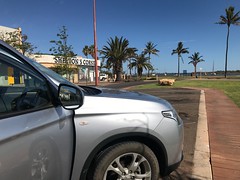 Alone in the Outlander, I continued my moochings around town. Here’s the Little House on the Highway which seemed so far out of town then. Here’s our place in Hill Street overlooking the oval. Here’s how I walked to primary school and later, to high school, past the hostel where station kids boarded.
Alone in the Outlander, I continued my moochings around town. Here’s the Little House on the Highway which seemed so far out of town then. Here’s our place in Hill Street overlooking the oval. Here’s how I walked to primary school and later, to high school, past the hostel where station kids boarded.
I walked from the Fascine across the old wooden bridge to Babbage Island, past people fishing from camp chairs, all the while following the old train tracks used to take bales of wool from Camel Lane across Babbage Island and then out to the end of the One Mile Jetty. The old tracks were still there, sometimes twisted or covered over with sand.
When I got to the One Mile, tourists were looking forlornly at the boarded up entrance. I had a coffee at the cafe and enjoyed the scenery, including a diagonal view of the white-painted jetty going out to sea; from this angle you wouldn’t even know it was closed. And I wandered all around the back of the Cafe/Museum complex, picking through the tangle of wood and metal remains of the glory days of trains and shipping and cargo and all the people and animals that used to come and go from this spot. I remembered how a circle of these flat wagons used to be out at the Pony Club; we’d run across the top of them, leaping from wagon to wagon.
I parked the Outlander on the road opposite The Little House on the Highway where we lived next-door-but one to the Thomases (note: the Thomases and the Sorensens are nothing like the Kellys and Johnsons of The Lucky Galah except in one respect: the Thomases had a giant wooden fork and spoon hanging on the wall, which I found a little Jack-and-the-Beanstalk freaky).
On the Tuesday, the day before Anzac Day, I did a second author talk, this time at the Library. This was very special. As you might imagine, I loved the library as a child. It was presided over by Mrs Dupree, who seemed strict and ancient but would unexpectedly smile at you. We’d get craft books out and go home and attempt the crafts. My sister Deb named one of our new grey kittens Abdul after the cat in the library book Abdul the Grey. But I wasn’t returning to that exact place to do my talk. The Library and Art Gallery are now housed in what used to be the squash courts. There was a bigger audience this time, thanks to the Library’s promotional efforts. It included Val Jolly of Jolly’s Tyres, where Dad worked for a while in the early 1970s and Enga Smith, who wrote Saddle in the Kitchen with its cover illustration by my old art teacher, David Bornshin. People were keen to chat with Tricia, whose family (the Fongs) ran Fongs Drapery and Haberdashery on the corner of Francis and Robinson streets for decades.
That evening, Tricia and I went back to the Library for a presentation by health writer Melissa Sweet who had recently completed a doctorate focusing on the lock hospital era. The audience was made up of Aboriginal people who had advised her, plus some non-Aboriginal townspeople and a few “strays” like Tricia and I. Island lock hospitals like the ones on Bernier and Dorre Islands off Carnarvon are a sad and sorry part of Australian history. The rounding up and imprisonment of Aboriginal people, many of whom were not actually ill, can only be described as barbaric. “It was a land grab,” said elder Raymond Edney simply and directly. “We’re still feeling it,” a couple of the women said. The meeting was attended by Bob Dorey and Kathleen Musulin who appeared with musician Peter Garrett on the SBS episode of Who Do You Think You Are. That episode focused on Garrett’s grandmother’s time as a nurse in the hospital. Kathleen Musulin’s great grandmother was incarcerated in the lock hospital. She is now part of a working group tasked with creating a memorial to acknowledge the pain and suffering wrought during that era.
My last full day in Carnarvon was Anzac Day, with the townspeople gathered around the War Memorial. We got up for the dawn service followed by bacon and egg rolls at the RSL Club. Tricia got chatting about history with the Shire President, Karl Brandenburg, who invited us to have a look at the display of historic photos in the Council chambers. As it turns out, the Council is now housed in the building that was the Library when I was a kid, so I got to snoop around in there after all. There, on the walls, was a display of all the iconic places I’d woven, in fictional form, into The Lucky Galah: the Fascine in different incarnations over the decades, the One Mile Jetty in full swing, the first truck to take bananas to Perth by road, the Dish when it was first built, NASA people at the tracking station in the 1960s.
The next day, as I waited for the Skippers plane, I saw these scenes again, this time in a small mural attached to the side of the terminal. There’s the 1960 flood, the One Mile, the bananas…
From the outside – if you’re just gathering supplies from the supermarket as you head further north in your camper van – Carnarvon admittedly doesn’t look like much. It’s just another small Australian town fighting for its life. From the inside, for those who live there or ever lived there, it is unforgettable. Its isolation, small population and giant landscape combine to create lives that seem hand-made out of the earth, sea and sky. I’ve taken some of this material and woven it into a work of fiction. I know I’m treading on unsteady ground here. People can get very upset with how you represent them. The Lucky Galah is not all beer and skittles. It encompasses darker corners of Australian life and politics and psyche. The risk of being excommunicated is ever-present. It may be one of the reasons I’ve taken so long to write this post. I wasn’t quite sure where I stood.
But you can never be sure where you stand. The river rushes on, the sea smashes into rock, history is made and forgotten. You’re just part of it all for a while.
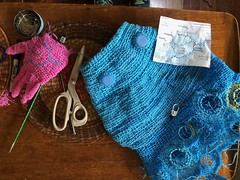 I’m crocheting a big blue Murray cod out of recycled baling twine. Anyone with horses, and anyone who has been hand-feeding stock through the drought, will be very familiar with the stuff. Starting out, I knew I’d need a lot of it. On spec, I rang a horsey business in Forbes, because I was going to be driving out there for something else, and asked if they had any blue baling twine lying about. Bullseye! First time lucky! I pulled up outside of a two-storey brick house on the edge of town, near the river. There were about eight horses in stalls out the back, and it had one of those back yards with a bit of everything in it – parts of machinery, old tins, building materials, the odd half-buried child’s toy. I knocked on the door. Silence. Try again. Wander around the back, noting two chained dogs watching but not barking. The horses watching, too. Note the large drifts of blue baling twine. Wonder if I should just start gathering it. Finally, a window opens on the second floor, and a bloke’s face appears in it. He explains he’s minding a small child so he can’t come down, but go right ahead. He watches me from the window as I gather up my treasure. It overflows my arms so I grab a large empty stock-feed bag and stuff the twine into that. I turn to go but the man in the window urges me on, clearly happy to be rid of the stuff. But I can’t take it all, there is just too much of it. I gather one or two extra bits to be polite and make my getaway.
I’m crocheting a big blue Murray cod out of recycled baling twine. Anyone with horses, and anyone who has been hand-feeding stock through the drought, will be very familiar with the stuff. Starting out, I knew I’d need a lot of it. On spec, I rang a horsey business in Forbes, because I was going to be driving out there for something else, and asked if they had any blue baling twine lying about. Bullseye! First time lucky! I pulled up outside of a two-storey brick house on the edge of town, near the river. There were about eight horses in stalls out the back, and it had one of those back yards with a bit of everything in it – parts of machinery, old tins, building materials, the odd half-buried child’s toy. I knocked on the door. Silence. Try again. Wander around the back, noting two chained dogs watching but not barking. The horses watching, too. Note the large drifts of blue baling twine. Wonder if I should just start gathering it. Finally, a window opens on the second floor, and a bloke’s face appears in it. He explains he’s minding a small child so he can’t come down, but go right ahead. He watches me from the window as I gather up my treasure. It overflows my arms so I grab a large empty stock-feed bag and stuff the twine into that. I turn to go but the man in the window urges me on, clearly happy to be rid of the stuff. But I can’t take it all, there is just too much of it. I gather one or two extra bits to be polite and make my getaway. Hours later, I dump it all onto the living room floor. There’s a satisfying amount of hay amongst the twine and a nice farmy smell. There’s some pink twine as well as the blue. I snip the machine-made knots out of it, sort it by colour, vacuum thoroughly.
Hours later, I dump it all onto the living room floor. There’s a satisfying amount of hay amongst the twine and a nice farmy smell. There’s some pink twine as well as the blue. I snip the machine-made knots out of it, sort it by colour, vacuum thoroughly.
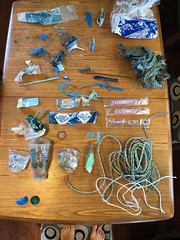 Along the way, I have become obsessed with blue plastic. On my walks around the soccer fields, alone now without Bertie the black Lab (who is now in eternal repose, so at odds with his personality, in the back yard between Taro the yellow Lab and Prince the tabby cat), all I can see is bits of blue plastic in the ground. I’m like a satin bower bird, attracted to the colour. Lots of lids from bottled water. Lots of Mentos packets and chip packets made of layers of plastic coated in a thin film of shiny aluminium.
Along the way, I have become obsessed with blue plastic. On my walks around the soccer fields, alone now without Bertie the black Lab (who is now in eternal repose, so at odds with his personality, in the back yard between Taro the yellow Lab and Prince the tabby cat), all I can see is bits of blue plastic in the ground. I’m like a satin bower bird, attracted to the colour. Lots of lids from bottled water. Lots of Mentos packets and chip packets made of layers of plastic coated in a thin film of shiny aluminium.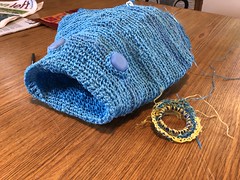 The size and shape of my fish is inspired partly by the image of Mr McBride holding the cod in the video, and partly by the length and width of my coffee table. I’m now about a third of the way along from the snout and I’ve already got a bit of the tail. But there’s a long road ahead, creating the body out of small stitches of single crochet.
The size and shape of my fish is inspired partly by the image of Mr McBride holding the cod in the video, and partly by the length and width of my coffee table. I’m now about a third of the way along from the snout and I’ve already got a bit of the tail. But there’s a long road ahead, creating the body out of small stitches of single crochet.








